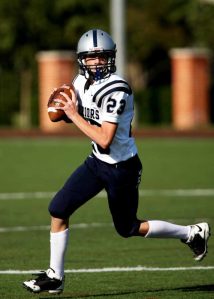
By Chris Birsner and Dan Quinones
There has been a significant rise in people who are concerned about the safety of tackle football over the years, with many studies linking concussions to chronic traumatic encephalopathy (CTE). However, a study published in Brain, a journal of neurology, presents a case that repeated hits to the head, even those that don’t present any signs of injury, are the leading cause of CTE.
“There are changes to the brain after these subconcussive type of hits, which are hits to the head or body that causes the brain to change its functionality a bit,” said Dr. Rupinder Johal, a sports medicine physician with Winthrop University. “We’re seeing it a lot at the high school level. Pre- and post-season, they do these functional MRIs and they are seeing that there are changes to the brain on a cellular-metabolic level after the season because of multiple subconcussive hits. We’re seeing that in those who have a documented concussion and those who don’t. Unfortunately, we’re just capturing the ones that present with symptoms.”
Johal notes that the longer you play football, the more likely you’ll get a concussion. In a study published in the journal Translational Psychiatry, researchers from Boston University’s Chronic Traumatic Encephalopathy Center studied 214 former football players at different levels of the sport and found that playing tackle football before the age of 12 increased the odds of behavioral and cognitive issues later in life. A total of 1.23 million children ages 6-12 played tackle football in 2015 according to data from the Sports & Fitness Industry Association.
Not everyone believes delaying the start of a youngster’s football career is a good idea. Tonia Torrellas, who runs the Hicksville Football Association, is an advocate for kids getting into the game at an early age. When she heard the argument that kids should not play until high school, she remembered when a 13-year-old who had never played football decided to join a team.
“He was phenomenal,” said Torrellas. “The kid literally just walked onto the field and he was ready to be the star player. Everyone was so excited about him. He got hurt in practice. It wasn’t a head injury, but I remember the injury that he got, there was something about it. I really felt, and others did too, that injury might not have happened had he been playing throughout because it was kind of like he froze a little and didn’t go with it.”
She argues that by teaching young players the proper fundamentals of tackling at an early age, they will know how to properly hit and how to take a hit when they get older and stronger. Safety professionals say players should be leading with their shoulders rather than their heads and avoid making contact with the other player’s head. According to BrainandSpinalCord.org, less than 44 percent of youth league coaches were trained in proper tackling techniques in 2015.

In Johal’s eyes, teaching better tackling methods can be part of the prevention of concussions and CTE, but it isn’t the complete cure.
“There needs to be a little more regulation,” said Johal. “Football has been around for decades and it’s hard for us to go around and say ‘Hey, this is not safe. Don’t play.’ I think regulations that have been placed already with the NFL as far as hitting, spearing and trying to avoid certain types of tackles can help prevent, but we’re not saving every player out there.”
According to BrainandSpinalCord.org, it has been estimated that a 9 to 12-year-old playing tackle football in an organized league can take on between 240 and 585 hits to the head each season.
The rise of CTE concern has also been a contributing factor in the rise of flag football. Jose Torres, commissioner of the Under The Lights flag football league, loves both tackle and flag football because of what they both bring to the table.
“I think they are both great,” said Torres, “I think tackle football, you focus more on the physical aspect of the game. For flag football, you focus more on the skill aspect of the game. Which they are both beneficial.”
Torres has had parents sign their kids up for the league who have concerns about their kids playing tackle football, but there are also parents who want their kids to develop better skills for tackle football by joining the league.
“Kids are having fun,” Torres said. “There’s less physical contact and that takes a toll on your body. There’s no question about that. But, you are having fun, you are in a competitive environment and you are still playing the game of football we all love.”
While there is no right or wrong answer as to when football players should learn to tackle, those who love football will be watching closely as CTE and concussion concerns grow.
“I think we’ll see a lot more come out over the next few years about concussions and CTE. There’s just so much to research at this point,” said Johal.

































